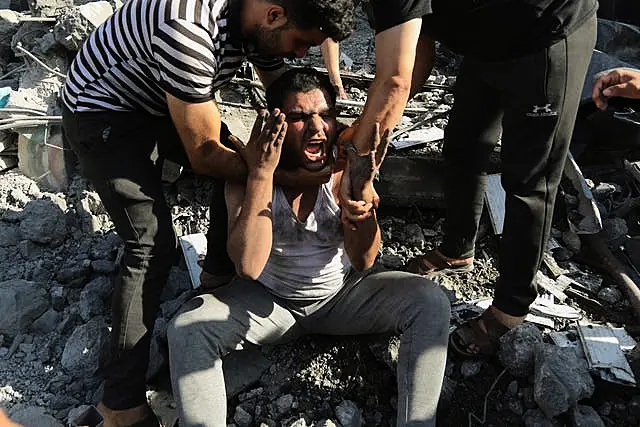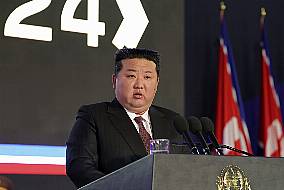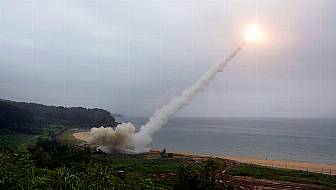Israeli military strikes have killed multiple civilians at a UN shelter and hospital in the Gaza Strip’s main combat zone.
It comes as the attack intensified on the besieged enclave’s Hamas rulers and the United States and Arab partners disagreed on the need for an immediate ceasefire.
Large columns of smoke rose from Gaza as Israel’s military said it had encircled Gaza City, the target of its offensive to crush Hamas.
US secretary of state Antony Blinken met with Arab foreign ministers in Jordan a day after talks in Israel with Prime Minister Benjamin Netanyahu, who insisted there can be no temporary ceasefire until all hostages held by Hamas are released.

Jordan’s foreign minister Ayman Safadi said Arab countries seek an immediate ceasefire.
“The whole region is sinking in a sea of hatred that will define generations to come,” Mr Safadi said.
Mr Blinken, however, said “it is our view now that a ceasefire would simply leave Hamas in place, able to regroup and repeat what it did on October 7.”
He said the US believes humanitarian pauses can be a “critical mechanism in protecting civilians, in getting aid in and getting foreign nationals out, while still enabling Israel to achieve its objective, the defeat of Hamas”.
Egyptian officials said they and Qatar were proposing humanitarian pauses for six to 12 hours daily to allow aid in and casualties to be evacuated.
They were also asking for Israel to release a number of women and elderly prisoners in exchange for hostages held by Hamas, suggestions Israel seems unlikely to accept.
They spoke on condition of anonymity because they were not authorised to brief the press on the discussions.

On Saturday, Israel offered a three-hour window for trapped residents to flee south, but as the window closed, there was no immediate information on how many fled.
The Israeli military asserted that Hamas “exploited” the window to move south and attack its forces.
There was no immediate Hamas comment on that claim, which was impossible to verify.
Israel has repeatedly demanded that northern Gaza’s 1.1 million residents flee south as it escalates bombardment of the north.
However, some of those travelling south were killed in recent days and Israel has continued bombing in the south, saying it is striking Hamas targets.
With wide swaths of residential neighbourhoods levelled in airstrikes, most of northern Gaza’s remaining residents, estimated at around 300,000, have sought shelter in UN-run schools and in hospitals where they hope they will be safe.
But deadly Israeli strikes have also repeatedly hit and damaged those shelters.

The UN agency for Palestinian refugees has said it has lost contact with many in the north.
On Saturday, two strikes hit a UN school-turned-shelter sheltering thousands just north of Gaza City, killing several people in tents in the schoolyard and women who were baking bread inside the building, according to the UN agency.
Initial reports indicated that 20 people were killed but the agency has not yet been able to verify the figure, said spokeswoman Juliette Touma.
The Health Ministry in Gaza reported that 15 people were killed at the school and another 70 wounded.
Also on Saturday, two people were killed in a strike by the gate of Nasser Hospital in Gaza City, according to Medhat Abbas, Health Ministry spokesman.
The World Health Organisation on Saturday called attacks on health care in Gaza “unacceptable”.
About 1.5 million people in Gaza, or 70 per cent of the population, have fled their homes, according to the UN.

With food, water and the fuel needed for generators that power hospitals and other facilities running out, UN secretary-general Antonio Guterres on Friday urged an immediate ceasefire to allow aid in, calling the humanitarian situation in Gaza “horrific”.
He also said civilians must not be used as human shields and called upon Hamas to release all of the roughly 240 hostages it has.
Incoming aid lorries in recent days have contained far more body bags than canned food, said Wael Abu Omar, a spokesperson for the Rafah crossing, Gaza’s only portal to the outside world.
The family home of Hamas’s exiled leader Ismail Haniyeh, in the Shati refugee camp on the northern edge of Gaza City, was hit on Saturday morning by an airstrike, according to the Hamas-run media office in Gaza.
It had no immediate details on damage or casualties.
Another strike hit near the entrance to the emergency ward of Al-Quds Hospital in Gaza City on Saturday afternoon, injuring at least 21, the Palestinian Red Crescent said.
In the town of Khan Younis in southern Gaza, an airstrike early on Saturday destroyed the home of a family, with first responders pulling three bodies and six injured people from the rubble.

Among those killed was a child, an Associated Press cameraman at the scene said.
Raed Mattar, who was sheltering in a school in Khan Younis after fleeing the north, said he regularly heard explosions.
“People never sleep,” he said. “The sound of explosions never stops.”
The Israeli military said ground forces are also now operating in the south, with an armoured and engineering corps working to remove booby traps from buildings.
Anger over the civilian deaths in Gaza sparked large demonstrations in Paris, London, Pakistan and elsewhere. “Against apartheid, free Palestinians,” a banner in Rome read.
Skirmishes along Israel’s northern border continued on Saturday as the Israeli military said it struck militant cells in Lebanon trying to fire at Israel, as well as an observation post for Hezbollah, an ally of Hamas.
Throughout the war, Israel and Hezbollah have traded fire almost daily along the Lebanese border, raising fears of a new front opening there.
After touring Israel’s northern border, minister of defence Yoav Gallant said that “we are not interested in a northern front, but we are prepared for any task. The air force is preserving most of its might for the Lebanon front”, according to a video statement released by his office on Saturday.







